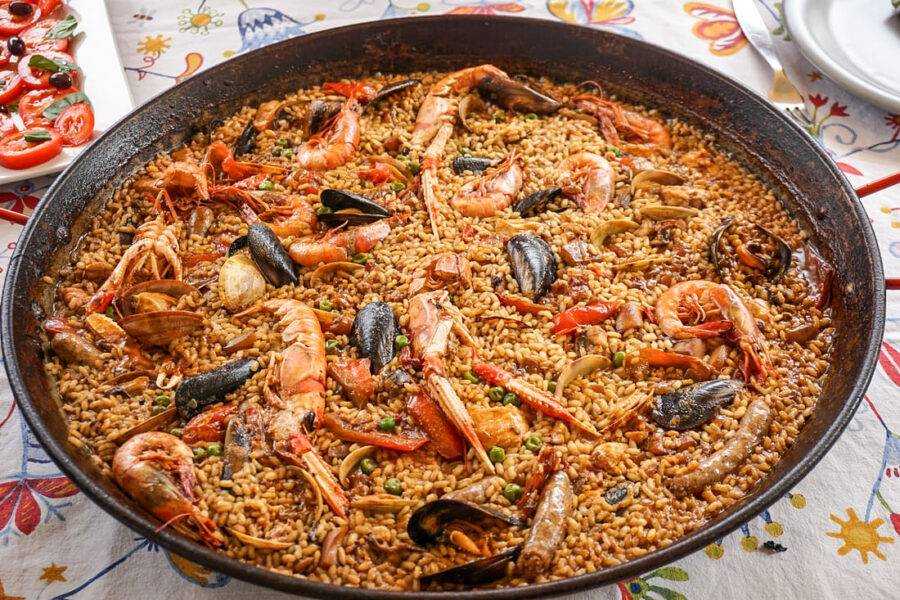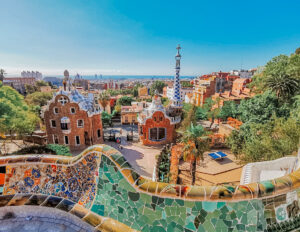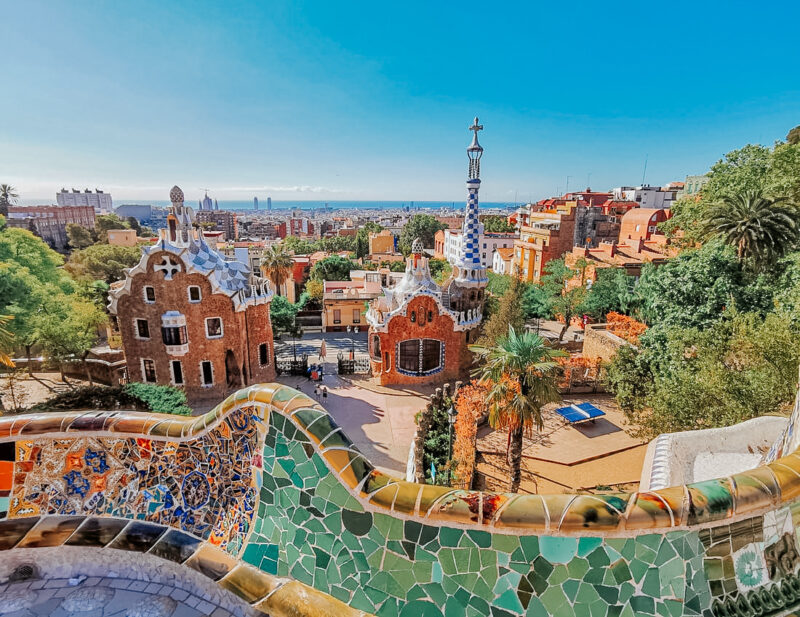What to Eat in Spain: 20 Must-Try Spanish Dishes
There’s no better way to experience a country than to indulge in local cuisine. In this guide, we will explore what to eat in Spain highlighting some of the must-try dishes and regional specialties that make Spanish food so beloved worldwide. It will take you on a culinary journey that will tantalize your taste buds. Trying new foods is our favorite part of traveling and Spain just happens to be one of our favorite food destinations in the world.
Spain is renowned for its rich culinary heritage, where each region offers its own unique flavors and traditional dishes. From the seaside restaurants in Valencia to the bustling markets of Barcelona and Madrid, Spanish cuisine is a delightful mix of simple, fresh ingredients, and bold flavors.
Although you’ll find some of the globally appealing dishes like paella and churros throughout the country, each region in Spain has its own food specialties. From delicious Paella, and patatas bravas to Basque cheesecake and churros, the Spaniards know how to create delicious food using simple, fresh ingredients.
Knowing what to eat in Spain can be tough when you have limited time while visiting the country. We spent almost 4 months traveling through Spain and visited cities like Barcelona, Madrid, Granada, San Sebastian, and Seville along with lesser-known but equally delicious destinations in the Costa Brava and Costa Blanca regions to come up with this Spanish food guide with must-try dishes in Spain. In this Spanish food guide, you’ll find some incredibly delicious and traditional foods to try during your time in Spain.
** Disclaimer: Please note some of the links in this post are affiliate links. Purchasing through these links earns us a small commission at no extra charge to you.
Table of Contents
ToggleWhat to Eat in Spain: 20 Must-Try Spanish Dishes
1. Tapas: Small Bites with Big Flavors
Tapas are your quintessential Spanish experience and no visit to Spain is complete without indulging in tapas. These small, savory dishes are perfect for sharing and allow you to sample a variety of flavors in one meal. Tapas are a staple of Spanish dining culture, and you can find them in bars and restaurants across the country. They are perfect for a casual meal and a great way to begin your culinary journey of Spanish food.
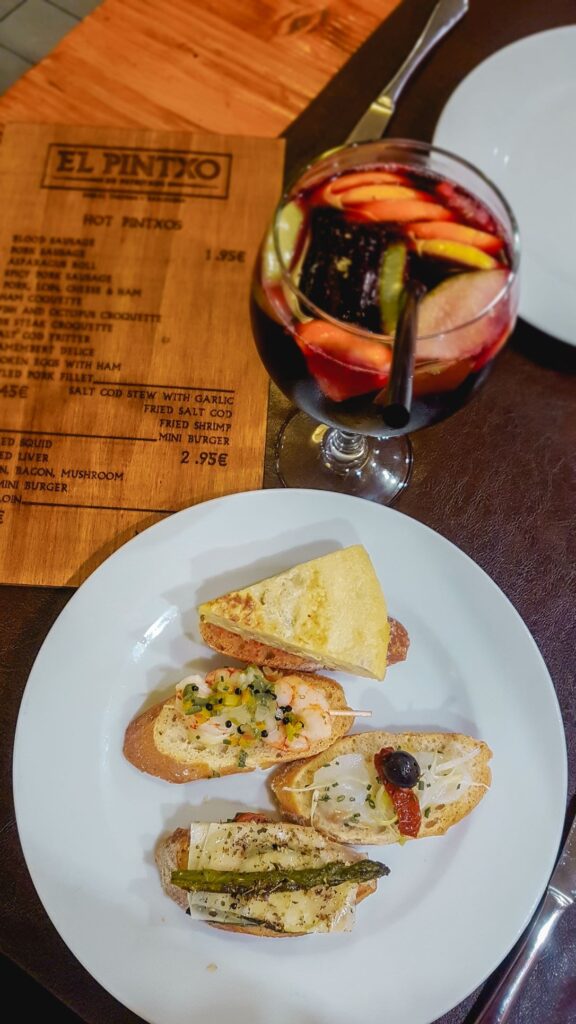
Some popular tapas include:
- Patatas Bravas: Crispy fried potatoes served with a spicy tomato sauce and aioli.
- Gambas al Ajillo: Shrimp sautéed in garlic and olive oil, often with a touch of chili.
- Jamón Ibérico: Thinly sliced, cured ham made from Iberian pigs, known for its rich, nutty flavor.
Meal times are a lot later in Spain, so locals often order a few tapas to keep them going till their main meal. It’s also a popular way to socialize.
2. Paella: The Pride of Valencia
Originating from the region of Valencia, Paella is arguably the most famous Spanish dish. The dish can be found all over Spain, however, if you make it to Valencia, I’d highly recommend trying the original Paella with rabbit, chicken, and butter beans.
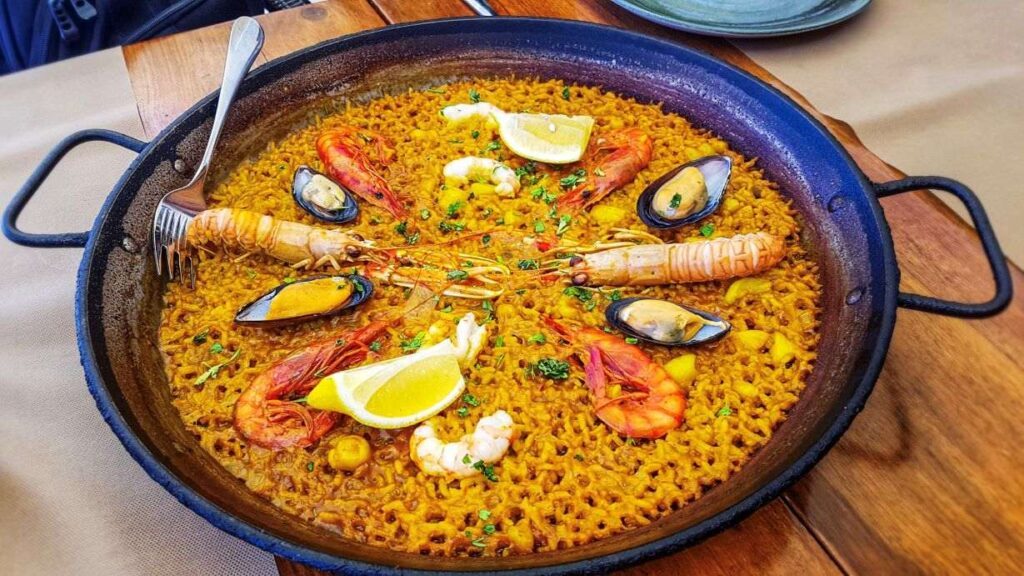
This iconic hearty rice dish is cooked in a wide, shallow pan and traditionally includes ingredients like rabbit, chicken, and vegetables, although seafood paella is also incredibly popular. Ingredients such as saffron give the rice its distinctive golden color. It’s comfort food at its finest!
To enjoy authentic paella, look for restaurants that prepare it fresh to order. If you’re looking for something a bit different, try the Arroz Negro (Spanish Squid Ink Rice). Don’t let the color throw you off as it’s incredibly delicious.
3. Tortilla Española: A Classic Spanish Omelette
The Spanish omelet, or Tortilla Española, is a simple yet delicious dish made with eggs, potatoes, and onions (onions are a bit controversial as it depends on who’s making it). It’s cooked slowly to ensure the inside remains soft and moist while the outside is perfectly browned. I was told that this dish requires a lot of practice to achieve the ideal texture. It can be enjoyed hot or cold and is usually served as a tapa or a main course and is often served with a piece of bread.
Each region in Spain has its own take on the tortilla, and you might find variations that include ingredients like chorizo or peppers.
4. Jamón
Did you know Spain is the world’s number one producer of dry-cured ham? Jamón is a Spanish delicacy, renowned for its rich flavor and intricate production process. It is a dry-cured ham, with the most famous varieties being Jamón Serrano and Jamón Ibérico. Jamón Serrano, made from white pigs, is known for its lean texture and slightly salty taste, while Jamón Ibérico, from the black Iberian pigs, offers a more complex, nutty flavor.
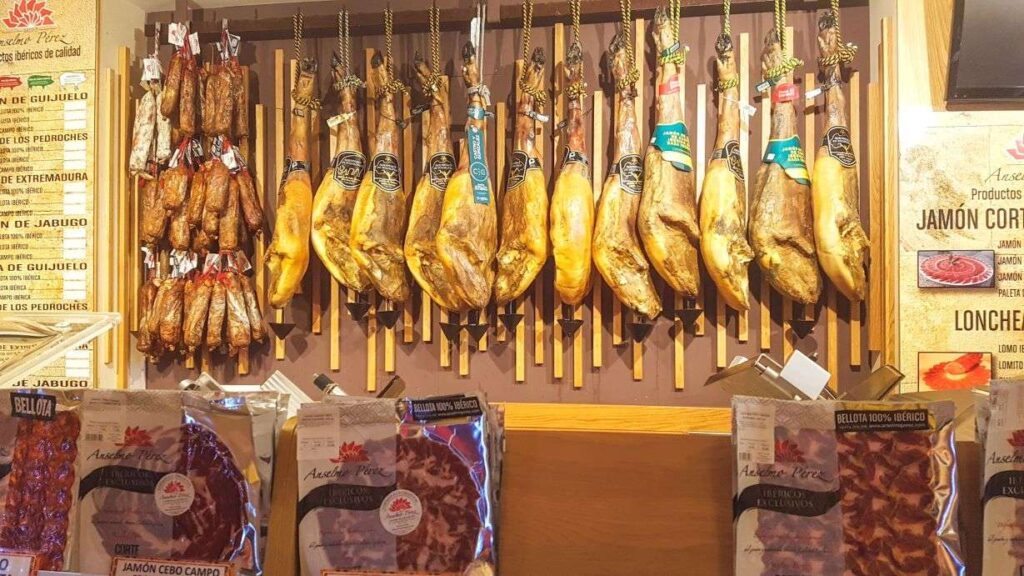
The hams are meticulously cured for several months to years, depending on the quality and type, resulting in a deep, savory, and sometimes sweet flavor profile that is celebrated in Spanish cuisine and enjoyed worldwide. You’ll see legs of salty jamón hanging at market stalls and on restaurant and bar menus all across Spain.
If someone were to ask me what to eat in Spain, Jamón would be one of the top things on my list. Jamón was one of our favorite things to eat as it was so easily accessible and perfect for carrying around as a snack on those long sightseeing days. If we were able to bring some back home with us, you best bet we’d have a carry-on bag filled with this stuff.
5. Albondigas
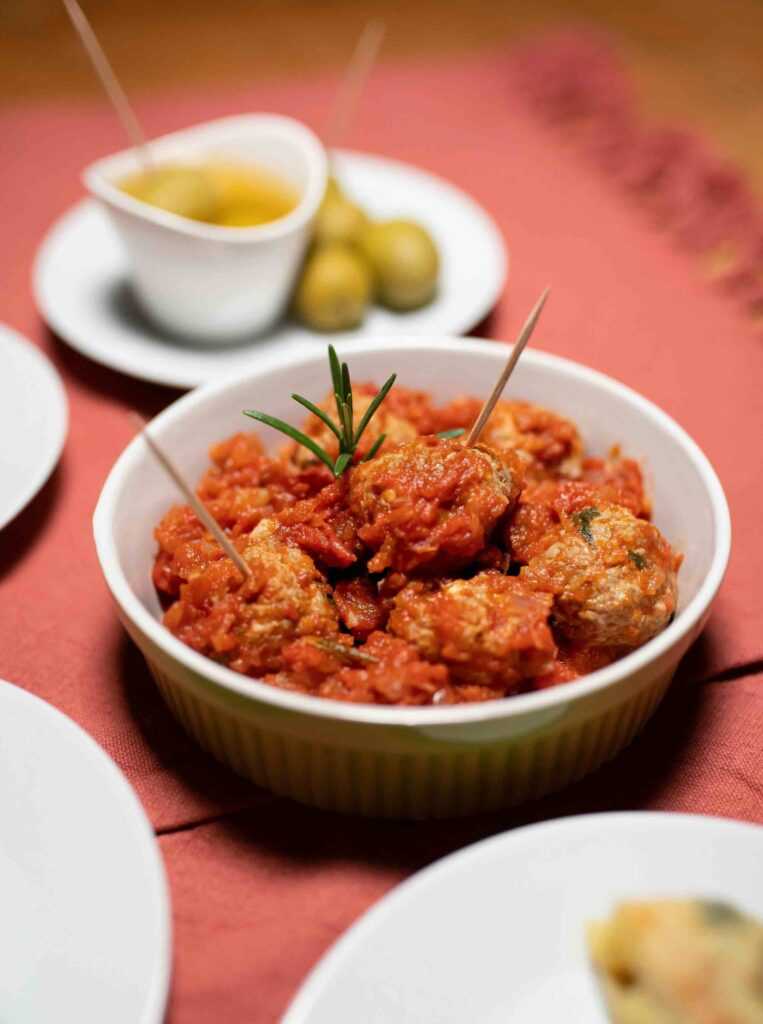
This popular Spanish dish consists of flavorful meatballs typically made from a mixture of ground beef or pork, breadcrumbs, herbs, and spices. These meatballs are often simmered in a rich tomato-based sauce They are commonly enjoyed as tapas, served in small portions with a side of crusty bread. This comforting dish is cherished for its savory taste and versatility, making it a beloved staple in many households.
6. Patatas Bravas
This dish is on every tapas menu and quite frankly, with its bold flavors and satisfying texture, you’ll find yourself ordering it wherever you go.
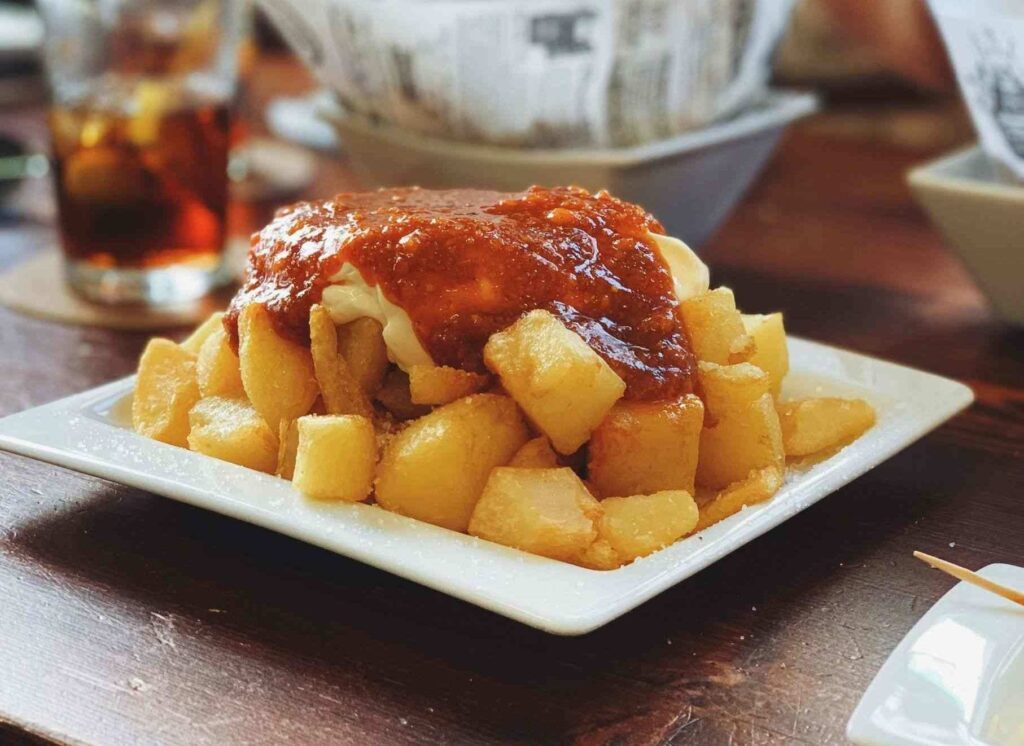
Delicious bites of crispy, golden-fried potato cubes are served with a spicy tomato sauce made with paprika and often accompanied by a garlicky aioli. It’s the perfect tapa for sharing or ordering as a side dish.
7. Spanish Chorizo
Spanish chorizo is a highly flavorful and versatile cured sausage. It is made from chopped pork seasoned with paprika, garlic, and other spices. It is renowned for its distinctive smoky and spicy profile and is available in two main varieties: Picante (spicy) and dulce (sweet). The paprika gives the chorizo its characteristic deep red color and rich flavor.
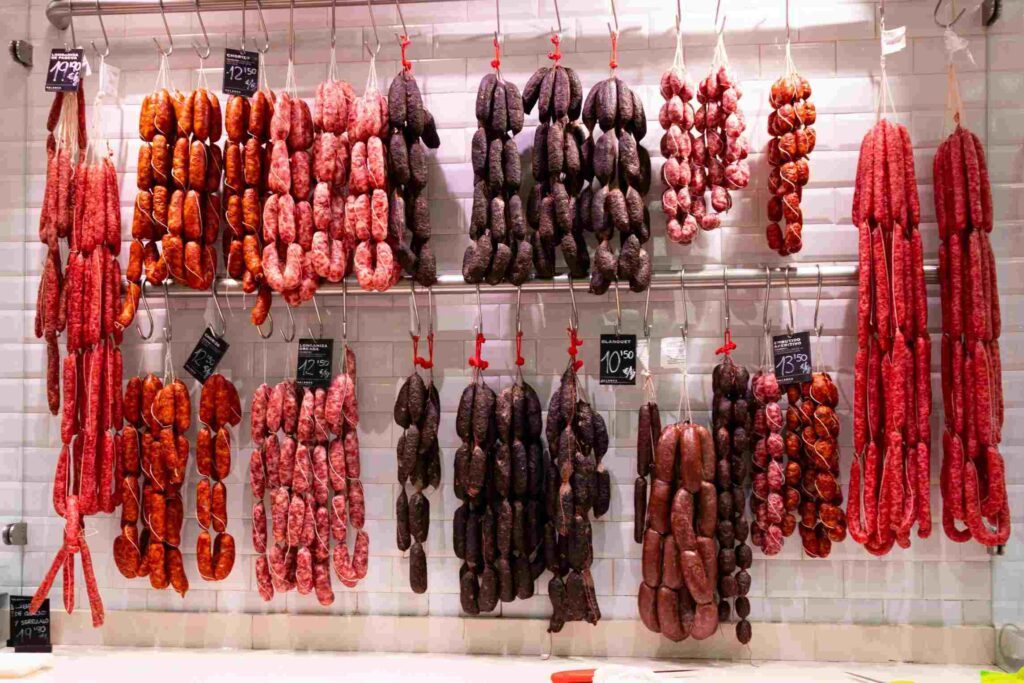
This sausage can be enjoyed on its own as a tapa or can be added to other dishes such as stews, paellas, and other dishes.
8. Gambas Al Ajillo
Gambas al Ajillo is a classic Spanish tapas dish celebrated for its simplicity and bold flavors. It is a classic Spanish dish that features succulent shrimp sautéed in olive oil with generous amounts of thinly sliced garlic, sometimes accompanied by a hint of dried red chili for a subtle heat. A splash of lemon juice and fresh parsley are typically added to enhance the dish. This dish is served in a sizzling hot clay dish.
9. Gazpacho: A Refreshing Andalusian Soup
I know the idea of a chilled soup may not sound very appealing, but wait till you’ve tried Gazpacho. It is a chilled tomato-based soup that originates from the southern region of Andalusia. It’s a perfect dish for hot summer days, made with ripe tomatoes, bell peppers, cucumbers, garlic, and olive oil, all blended until smooth. Gazpacho is typically served cold and garnished with diced vegetables or croutons.
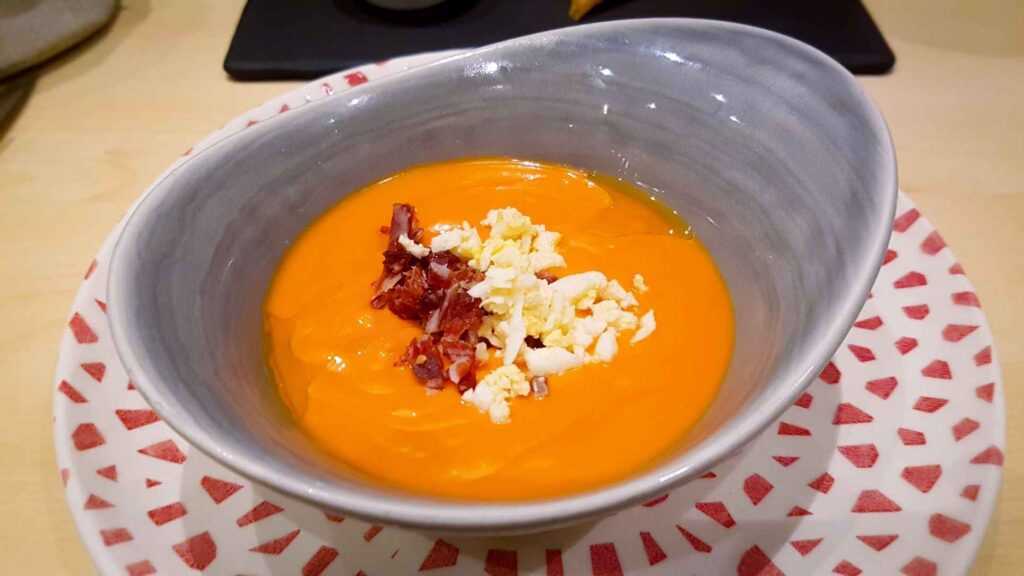
Salmorejo is another variation, a thicker version of gazpacho that includes bread in the mixture, often topped with hard-boiled eggs and jamón.
A must-try dish when visiting Spain, especially in summer. We took a cooking class in Seville where we learned to make Gazpacho and it was incredibly easy to do.
10. Croquetas: Creamy Fried Bites
Croquetas are another popular tapa in Spain that will always nearly be served in any restaurant or tapas bar. These small, oval, breaded, fried bites are filled with béchamel sauce and various ingredients like ham, chicken, or cod. The exterior is crispy while the inside is creamy and flavorful.
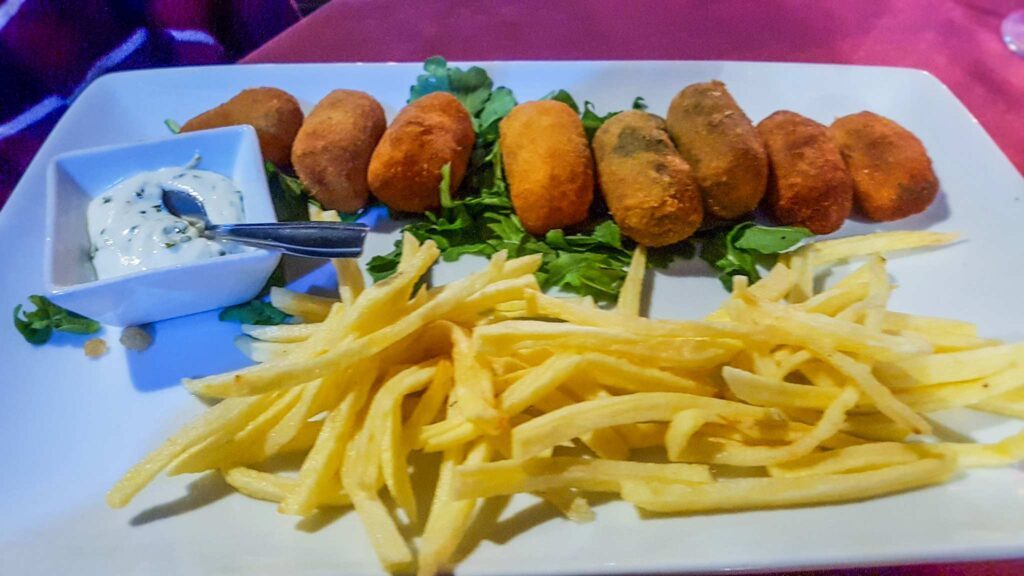
The most common croqueta you’ll find on the menu are ‘croquetas de jamón’ (croquettes with ham). Perfect bite-sized snack. We ordered these at almost every meal for our 3-year-old son.
11. Empanadas: Savory Pastries
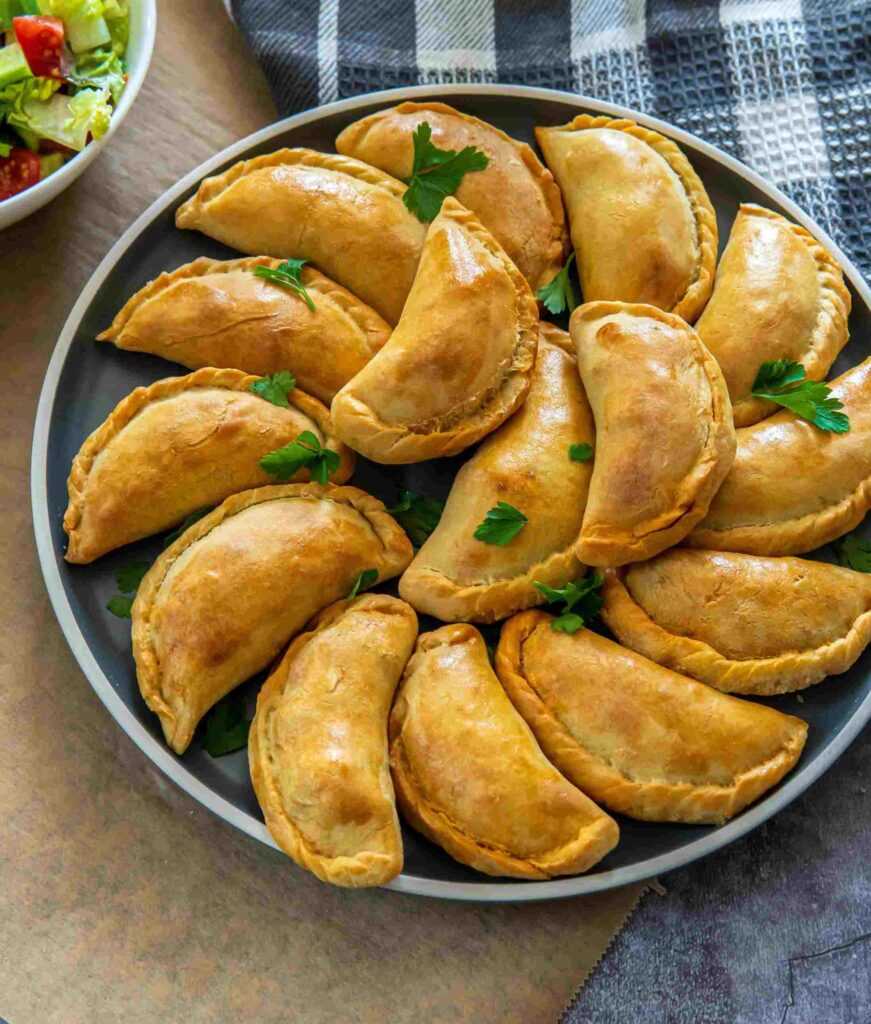
These delicious morsels of food are savory pastries filled with a variety of ingredients, including meat, fish, or vegetables. Each region of Spain has its own version, but they are all delicious and are a perfect snack on the go.
12. Calamares a la Romana: Fried Calamari
Calamares a la Romana is a popular dish of deep-fried squid rings, often served with a slice of lemon and aioli. You’ll find this in most tapas bars and seaside restaurants in Spain.
13. Pan Con Tomate
This tapa dish is traditionally from the Catalonia region and is made up of lightly toasted sliced bread rubbed with garlic and tomato. It’s then finished off with a drizzle of olive oil and a pinch of salt. I love topping mine with some thinly sliced Spanish ham.
14. Pimientos de Padron
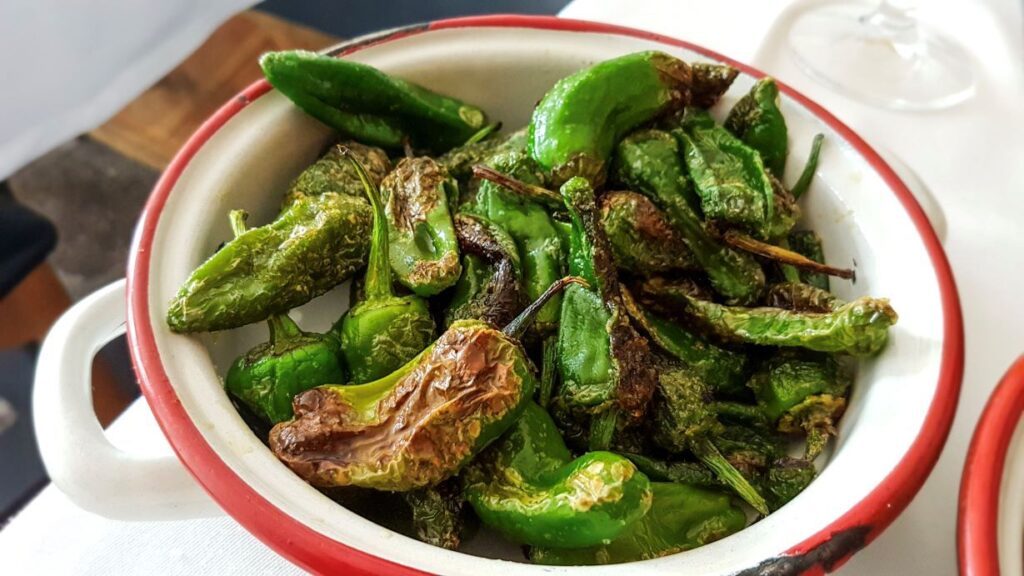
Pimientos de Padrón are small green peppers from the region of Galicia. They are fried in olive oil and sprinkled with sea salt. They aren’t spicy and make such a great snack along with a glass of wine or Sangria.
15. Manchego Cheese
Manchego cheese is a renowned Spanish cheese hailing from the La Mancha region, made exclusively from the milk of Manchega sheep. It is known for its firm and compact texture, and its distinctive, inedible rind.
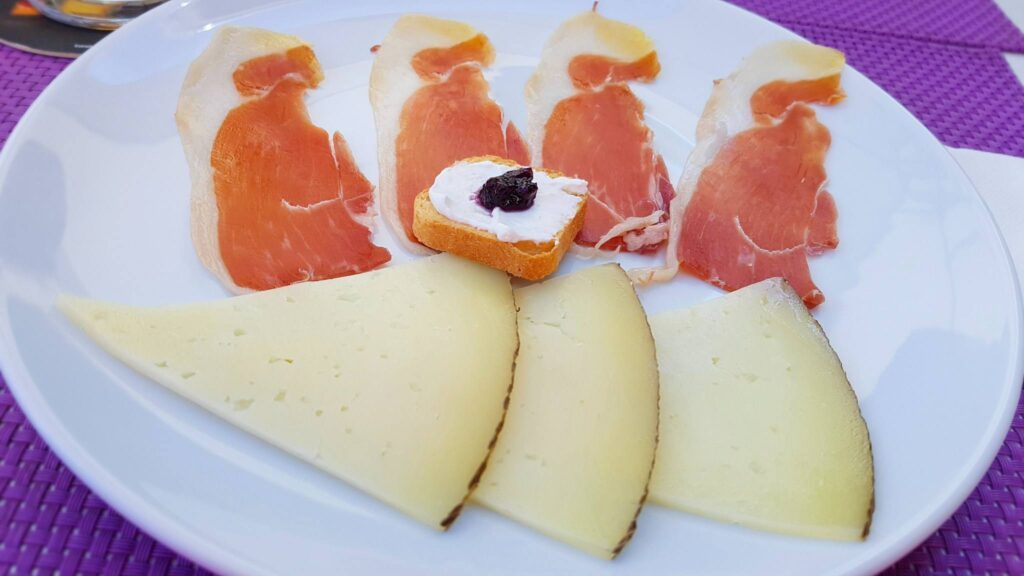
The flavor of Manchego varies with age: younger cheeses are milder and creamier, while aged versions develop a sharper, more robust taste with nutty and buttery notes. Typically aged for anywhere between 60 days to two years, Manchego cheese is often enjoyed on its own, paired with fruits and nuts, or as part of a tapas platter.
16. Pisto: Spanish Ratatouille
This is Spain’s version of a ratatouille, a stewed vegetable dish that is particularly popular in the region of La Mancha. It typically includes tomatoes, peppers, zucchini, and onions, cooked in olive oil until tender. Pisto is often served with a fried egg on top and crusty bread on the side. This dish certainly showcases fine Spanish ingredients.
17. Cochinillo Asado: Suckling Pig
This dish features a young pig, roasted whole to achieve a crispy, golden-brown skin and tender, juicy meat. The preparation is simple yet meticulous, often involving just a sprinkle of salt and a slow roast in a traditional wood-fired oven. The result is a succulent and flavorful meat with a delicate, melt-in-the-mouth texture. Cochinillo Asado is a symbol of festive gatherings and special occasions, embodying the rich culinary traditions and communal spirit of Spanish culture. It’s not as common throughout Spain and tends to be more popular in Madrid and Segovia.
18. Churros con Chocolate: A Sweet Treat
This literally translates to Churros with chocolate. Churros are deep-fried dough pastries, crispy on the outside and soft on the inside, sprinkled with sugar. They are typically enjoyed by dipping them into thick, rich hot chocolate. In Spain, this popular treat is enjoyed for breakfast or as a sweet afternoon snack, especially in Madrid.
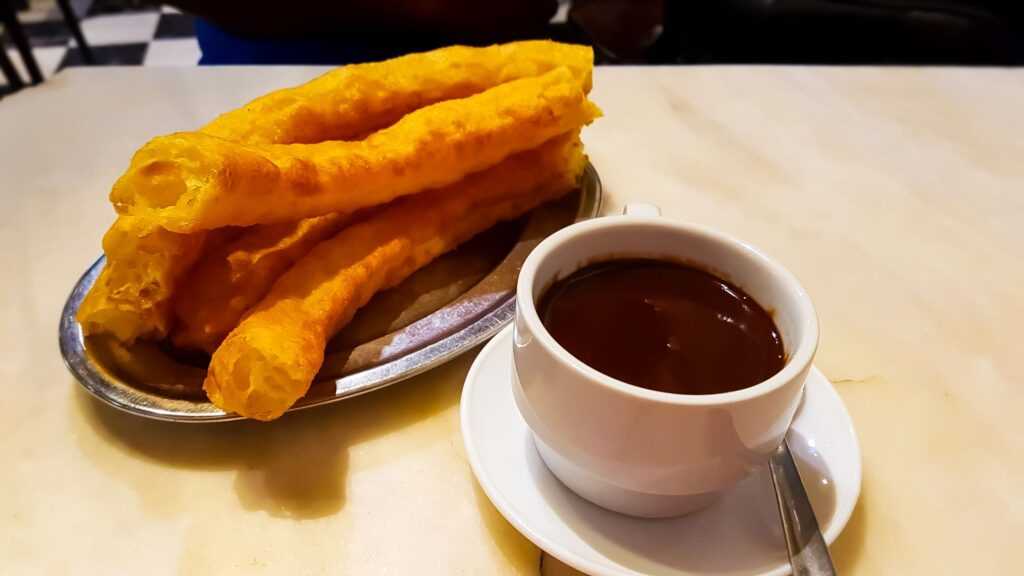
Churros can be found all over Spain. If you go to Madrid, try them at the famous Chocalateria San Gines.
19. Bocadillo
A Bocadillo is a traditional Spanish sandwich that typically consists of a baguette-style bread filled with a variety of ingredients. It is a popular and versatile snack or meal, enjoyed throughout Spain. Common fillings include cured ham (jamón), chorizo, cheese, tuna, and tortilla de patatas.
Bocadillos are often enjoyed at any time of the day, from breakfast to dinner, and are a staple in Spanish cuisine. They can be found in cafes, bars, and bakeries across the country, making them an integral part of Spanish food culture.
20. Turrón
Turrón is a traditional Spanish confectionary essentially a type of nougat that is made from honey, sugar, egg whites, and toasted almonds. It is especially popular during the festive season. You can get this in a soft, chewy texture or a firm and brittle texture. Either way, it is delicious!
Regional Specialties to Explore – What to Eat in Spain?
Spain’s diverse regions each have their own culinary specialties that reflect local traditions and ingredients. Here are a few regional dishes worth seeking out:
- Basque Country: Pintxos
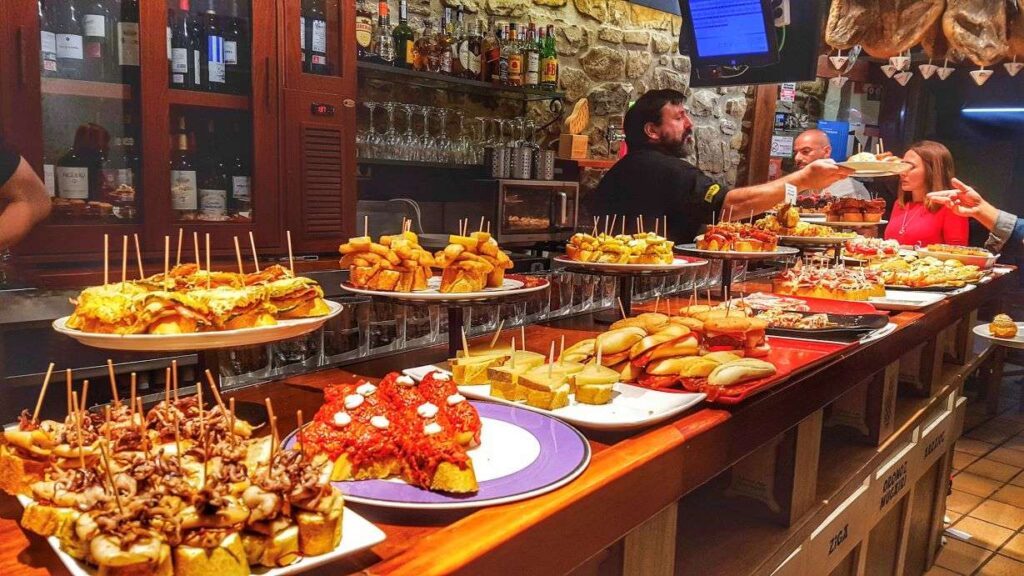
In the Basque Country, pintxos (pronounced “peen-chos”) are the local version of tapas. These bite-sized snacks are often served on a piece of bread with a toothpick holding the ingredients together. Pintxos can range from simple combinations of cheese and ham to more elaborate creations featuring seafood, vegetables, and sauces.
- Catalonia: Escudella
Escudella is a traditional Catalan stew typically enjoyed during the winter months. It includes a variety of meats such as pork, beef, and chicken, along with sausages, vegetables, and chickpeas. The stew is cooked slowly, allowing the flavors to fuse together beautifully. It’s a hearty dish that showcases the robust flavors of Catalonia.
- Pulpo a la Gallega: Galician Octopus

Galicia, located in the northwest of Spain, is renowned for its seafood. Pulpo a la Gallega is one of its most famous dishes, featuring octopus cooked until tender, then seasoned with olive oil, paprika, and sea salt, and served with boiled potatoes. It is one of my favorite tapas to eat.
- Fabada
This Asturian dish is a stew consisting of beans, chorizo, blood sausage, and bacon slowly cooked in water. The fats from the pork create a hearty soup perfect for the colder months. You can actually find Fabada in cans at the grocery store, although you are better off getting it freshly made at a restaurant.
- Fideuá
This dish is similar to paella but made with short-grain noodle and topped with seafood. It’s more commonly found along the east coast of Spain.
Spanish Desserts: What to eat in Spain – Satisfy Your Sweet Tooth!
Spain also offers a variety of delicious desserts to end your meal on a sweet note. Some popular options include:
- Tarta de Santiago: A traditional almond cake from Galicia, often decorated with powdered sugar in the shape of the cross of Saint James.
- Flan: Flan is a classic dessert in Spain known for its creamy texture and rich caramel flavor. This delectable treat consists of a smooth, custard-like base made from eggs, milk, and sugar, topped with a layer of golden caramel sauce. The flan is typically baked in a water bath to achieve its signature silky consistency, then chilled and inverted onto a plate to showcase the glossy caramel topping. Its delicate sweetness and melt-in-the-mouth texture make flan a popular and indulgent dessert.
- Crema Catalana: Similar to crème brûlée, this dessert from Catalonia features a rich custard base topped with a layer of hard caramel.
Spanish Meal Times
Unlike most other parts of the world, Spanish meal times are quite different. Spaniards also tend to eat more frequently. So understanding meal times will help you avoid eating at tourist traps.
Breakfast: This meal is usually had between 7 a.m and 9 a.m and is usually very light and consists of something simple like pan con tomate or a croissant.
Lunch: This is the largest meal of the day and is generally enjoyed between 2.30 p.m and 3.30 p.m, so later than you’d be used to. You can find a mid-morning snack at a cafe to keep you going till lunch time.
Afternoon Snack: Dinner times in Spain are quite late, generally not till 8.30 p.m or 9 p.m. So the Spaniards tend to have a snack prior to dinner time. This usually takes place between 5.00 p.m and 7.00 p.m. Churros is a popular afternoon snack in Spain.
Dinner: This tends to be a light meal and consists of a few plates of tapas to share or a single dish. Dinner is anytime between 9.00 p.m and 11.00 p.m.
What to Drink in Spain?
Here are some drinks to try in Spain
- Wine
- Sangria: This signature Spanish beverage is made by soaking fruits such in red wine or cava.
- Agua de Valencia: This Spanish drink is probably the second most popular drink. Made from fresh orange juice, cava, gin, and vodka, this drink is popular in the northern part of Spain.
- Tinto de Verano: This is a cheaper and easier version of Sangria and is usually made by mixing red wine with lemonade
- Horchata: A refreshing drink made from tiger nuts, water, and sugar. Traditionally horchata is accompanied by long thin buns known as “fartons”.
- Beer
The Importance of Wine in Spanish Cuisine
No discussion of Spanish cuisine would be complete without mentioning the country’s excellent wines. Spain is one of the world’s top wine producers, known for its diverse wine regions and high-quality wines. We couldn’t give you a list of what to eat in Spain without letting you know what to drink in Spain. Some key wine regions include:
- Rioja: Famous for its red wines made primarily from Tempranillo grapes.
- Ribera del Duero: Another top region for robust red wines.
- Priorat: Known for its powerful red wines made from Grenache and Carignan.
- Cava: Spain’s sparkling wine, produced mainly in Catalonia.
Pairing these wines with Spanish dishes can elevate your dining experience, making it all the more enjoyable.
Final Thoughts
Spanish cuisine is a delightful blend of flavors, textures, and aromas, reflecting the country’s rich cultural and geographical diversity. From the iconic paella and refreshing gazpacho to the savory delights of tapas and the sweet indulgence of churros con chocolate, there’s something to satisfy every palate.
Whether you’re exploring the bustling markets of Madrid, the coastal seafood of Galicia, or the hearty stews of the Basque Country, the culinary experiences in Spain are as varied as they are delicious. So, the next time you wonder what to eat in Spain, let this guide lead you on a culinary journey through one of the world’s most beloved food cultures.
Enjoy your gastronomic adventure!
Here are some food tours that will highlight what to eat in Spain.
- Barcelona Tapas Tours with Wine!
- Madrid Food Tour
- Seville Cooking Class – Learn how to make Paella and Gazpacho
- Malaga Tapas Crawl
More information on your trip to Spain
- Top 26 Tourist Attractions in Spain
- The Ultimate Southern Spain Itinerary
- Best Places to Visit in Madrid
- A Day Trip from Barcelona to Montserrat
- 3 Days in Barcelona: The Ultimate Itinerary

